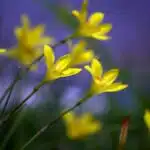Summer is a time when gardens and landscapes come alive with vibrant colors and scents. One of the best ways to achieve this colorful display is by planting summer-blooming bulbs. These bulbs are easy to care for, require minimal attention, and can provide a beautiful display of flowers that last for several weeks.
In this article, we will explore the top 10 summer-blooming bulbs that are easy to grow and maintain in any garden or landscape. From lilies to dahlias, these bulbs offer a range of colors, sizes, and shapes that can enhance the aesthetic appeal of your outdoor space. Whether you’re a seasoned gardener or just starting out, these bulbs are sure to add beauty and charm to your summer landscape.
The Beauty Of Summer-Blooming Bulbs
The beauty of summer-blooming bulbs is unrivaled in the world of garden design. These versatile plants add a touch of elegance to any landscape, making them an excellent choice for landscaping ideas. Whether you’re looking to brighten up your front yard or add some color to your backyard, summer-blooming bulbs are the way to go.
One of the most significant advantages of these bulbs is their ability to thrive in various soil types and climates. They’re also relatively easy to grow, making them a popular choice among novice and experienced gardeners alike. Plus, with so many different varieties available, there’s no shortage of options when it comes to choosing the perfect summer-blooming bulb for your garden.
Another reason why summer-blooming bulbs are so popular is that they come in a wide range of colors and sizes. From vibrant reds and oranges to soft pinks and yellows, there’s a shade for every taste preference. And thanks to their different heights and shapes, you can create unique garden designs that are sure to impress all who see them. So if you want to take your landscaping ideas to the next level, consider incorporating some beautiful summer-blooming bulbs into your design scheme.
As you plan your next gardening project, keep in mind that choosing the right bulbs for your garden is crucial. You’ll want to select varieties that complement each other well and work together harmoniously within your overall design scheme. Whether you opt for classic lilies or modern dahlias, be sure to choose bulbs that will thrive in your local climate and soil type. With a little bit of research and careful planning, you can create a stunning garden that will be the envy of everyone on your block!
Choosing The Right Bulbs For Your Garden
When it comes to bulb planting, selecting the right varieties is essential for a successful garden. Whether you’re looking to add color, texture, or fragrance to your outdoor space, there are several factors to consider before making your purchase. First and foremost, make sure you choose bulbs that are suited for your climate and soil type. This will ensure that they thrive and bloom as expected.
Another important consideration is the timing of when you plant your bulbs. Most summer-blooming bulbs should be planted in the spring, after the danger of frost has passed. However, some varieties may require different planting times depending on their specific needs. It’s always a good idea to do some research beforehand or consult with a professional gardener for bulb planting tips.
Lastly, consider the overall aesthetic you’re going for in your garden. Are you looking to create a colorful display of various blooms or a more cohesive look with complementary colors and textures? Whatever your preference may be, there are countless bulb varieties to choose from that can suit any style.
- Dahlias: These bold blooms come in a range of sizes and colors and can add drama and depth to any garden.
- Gladiolus: With their tall spikes of flowers in shades of pink, purple, white and more, gladiolus make excellent cut flowers.
- Liatris: Also known as blazing star or gayfeather, these spiky flowers add vertical interest with their tall stems covered in tiny purple flowers.
With these selecting bulb varieties tips in mind, you’ll be well on your way to creating a stunning summer garden filled with colorful blooms that last all season long. And if you’re looking for even more inspiration about which summer-blooming bulbs to choose from, keep reading about lilies: the perfect summer blooms!
Lilies: The Perfect Summer Blooms
After choosing the right bulbs for your garden, it’s time to focus on summer-blooming varieties. Lilies are a popular choice for many, as they come in a range of vibrant colors and require minimal care. However, there are other bulbs that also offer show-stopping blooms during the summer months.
One such option is the Gladiolus, known for its tall spikes of flowers in shades of pink, red, and purple. To grow these beauties, plant the corms in well-draining soil with full sun exposure. Water regularly to keep the soil moist but not waterlogged. As the plants grow taller, stake them to prevent them from falling over in strong winds.
Another popular choice is the Dahlia, which comes in a dizzying array of colors and shapes. From small pom-pom flowers to dinner-plate-sized blooms, there is a Dahlia for every taste. To grow these stunners, plant tubers in fertile soil with good drainage and full sun exposure. Water regularly and fertilize once a month with a balanced fertilizer. Deadhead spent blooms to encourage more flowers to form.
With their stunning colors and unique shapes, Dahlias have an allure that is hard to resist. In the next section, we will explore this beloved summer-blooming bulb in greater detail and offer tips on how to grow them successfully in your own garden.
The Allure Of Dahlias
Dahlias, with their vibrant colors and varieties, are a favorite among gardeners who want to add a splash of color to their gardens. They come in a wide range of sizes, shapes, and colors, from small pompons to large dinner-plate blooms. Some popular varieties include the cactus dahlia, which has long, pointed petals; the ball dahlia, which has round flowers; and the collarette dahlia, which has a single ring of flat petals around a central disc.
Dahlias are versatile plants that can be used in many different garden designs. They work well in borders and beds, where they can provide a bright accent to other plants or serve as the main attraction. They also make great cut flowers for bouquets and arrangements. With proper care and maintenance, dahlias will bloom all summer long and into early fall.
Whether you are looking to add some color to your garden or create stunning floral arrangements for your home or events, dahlias are an excellent choice. Their variety of colors and shapes make them perfect for any garden design or aesthetic. By incorporating dahlias into your landscape design, you can bring beauty and joy to your outdoor space throughout the summer months.
As we explore more summer-blooming bulbs in this article, we will take a closer look at sunflowers: the epitome of summer. These bright and cheerful blooms have been beloved by gardeners for generations for their bold colors and impressive size. Let’s delve into how sunflowers can enhance your garden design this season.
Sunflowers: The Epitome Of Summer
Few flowers are as iconic of summertime as sunflowers. These bright and cheerful blooms are the epitome of the season, with their tall stalks and large, vibrant petals that seem to radiate warmth and joy. Whether you’re growing sunflowers for their beauty or for their tasty seeds, they’re an excellent choice for any summer garden.
Growing tips:
- Sunflowers thrive in full sun and well-draining soil.
- Plant them in a spot with plenty of space, as they can grow quite tall.
- Keep the soil moist but not waterlogged, and fertilize every few weeks during the growing season.
There are many different varieties of sunflowers to choose from, each with its own unique characteristics. Some popular types include:
- Dwarf sunflowers, which are perfect for small gardens or containers.
- Giant sunflowers, which can grow up to 16 feet tall and have enormous flower heads.
- Multi-flowering sunflowers, which produce multiple blooms on a single stem.
If you’re looking for a classic summer favorite that’s sure to bring a smile to your face, look no further than the sunflower. With their bright colors, easy growing habits, and delicious seeds (if you can beat the birds to them!), these flowers are a must-have for any sunny garden. So go ahead and plant some today – your inner sunshine will thank you!
As we move into the next section about gladiolus: a classic summer favorite, it’s important to note that while these flowers may not be as instantly recognizable as sunflowers, they’re nevertheless beloved by many gardeners. So let’s take a closer look at this timeless bloom and all it has to offer.
Gladiolus: A Classic Summer Favorite
Sunflowers may be the epitome of summer, but there are other bulbs that can bring joy and beauty to your garden during this season. One of these is the gladiolus, a classic summer favorite. With their tall spikes of colorful flowers, they add a touch of elegance to any landscape.
Growing gladiolus is relatively easy. They prefer well-drained soil and plenty of sunlight. Plant them in the spring after the danger of frost has passed and space them about six inches apart. To get a longer blooming period, stagger planting times every two weeks until early summer. Keep the soil moist but not waterlogged as they grow, and fertilize with a balanced fertilizer once a month.
There are many popular varieties of gladiolus to choose from. The ‘Priscilla’ has creamy white flowers with deep pink centers, while the ‘Green Star’ has greenish-white petals with red markings. The ‘Blue Isle’ has striking blue-violet blooms that make a statement in any garden. With so many options available, there’s sure to be a gladiolus variety that fits your personal style and taste.
As you plan your summer garden, don’t forget about zinnias: a burst of color that will keep your outdoor space vibrant all season long.
Zinnias: A Burst Of Color
Zinnias are a popular summer-blooming bulb that can add a burst of color to any garden. It is interesting to note that there are more than 20 species and hundreds of cultivars of zinnias available in the market today. With so many options to choose from, it can be overwhelming for gardeners to pick the perfect zinnia color scheme for their garden.
When it comes to choosing zinnia color schemes, it is important to consider the overall theme of your garden. For a bright and bold look, go for vibrant colors such as reds, oranges, and yellows. If you prefer a more subtle look, choose pastel shades like pink, lavender, and cream. Mixing different colors and shades can create a stunning effect that will leave your guests in awe.
Planting zinnias is relatively easy even for novice gardeners. These bulbs thrive in well-drained soil with full sun exposure, making them ideal for gardens all over the world. To ensure healthy growth and blooming, plant zinnia bulbs at least six inches apart and water them regularly. Deadheading spent blooms can encourage new growth and prolong flowering throughout the summer months. With these simple planting tips, you can enjoy the beauty of zinnias in your garden all season long.
As we move on to our next topic about charming cosmos, it is worth noting that these flowers also share some similarities with zinnias in terms of their ease of planting and colorful blooms. Like zinnias, cosmos come in various colors including pinks, purples, whites, and oranges making them an excellent addition to any summer flowerbed. Let’s take a closer look at how you can incorporate the charming cosmos into your garden design!
The Charming Cosmos
Cosmos is a charming summer-blooming bulb that belongs to the Asteraceae family, with its origin traced back to Mexico. There are over 20 Cosmos varieties; however, the most common are Cosmos bipinnatus and Cosmos sulphureus. The former has pink or white petals surrounding a yellow center while the latter has orange or yellow flowers.
Growing cosmos requires a well-draining soil rich in organic matter and full sunlight. The ideal pH for growing these bulbs is between 6.0 and 7.0. Since they are drought-tolerant, it’s essential to water them only when the soil is dry. Overwatering can lead to root rot, which can be detrimental to their growth. Deadheading spent blooms will encourage further blooming, allowing you to enjoy their beauty throughout the season.
Cosmos varieties are low-maintenance plants that add color and vibrancy to gardens, borders, and containers. They attract pollinators such as butterflies and bees, making them an excellent addition to any garden aimed at attracting wildlife. With proper care and maintenance, cosmos bulbs can bloom from early summer until frost sets in.
Moving on from cosmos bulbs leads us into another delicate flower variety: begonias.
Delicate Begonias
As we bid adieu to the charming cosmos, let’s welcome the delicate begonias that bloom in summers. These flowers are a sight to behold with their vibrant colors and soft petals. Begonias are native to tropical regions and are available in various varieties that differ in color, size, and shape.
Begonia care is easy, making it a popular choice for novice gardeners. It requires well-draining soil and partial shade. Watering should be done regularly but not excessively as overwatering can lead to root rot. Fertilization should be done every two weeks during the growing season.
Some of the popular begonia varieties include Tuberous Begonias, Wax Begonias, Angel Wing Begonias, and Rex Begonias. Tuberous begonias have showy blooms that range from white, pink, red, orange, and yellow hues. Wax begonias are low-maintenance plants with waxy leaves that come in red or pink shades. Angel Wing Begonias have attractive foliage with silver spots and red undersides that contrast beautifully with its coral-colored blooms. Rex begonias have textured leaves with intricate patterns in varying shades of green or purple.
With their delicate blooms and easy care requirements, begonias are an excellent addition to any summer garden. In the next section, we will explore the elegance of calla lilies and how they can enhance the visual appeal of your outdoor space.
The Elegance Of Calla Lilies
Calla Lilies are renowned for their elegance and beauty. These summer-blooming bulbs feature trumpet-shaped flowers that come in a range of colors, from classic white to deep purple. They are easy to grow and care for, making them a popular choice among gardeners and florists alike.
Calla Lily Care is relatively simple. They require well-drained soil and plenty of sunlight to thrive. It is important to keep the soil moist but not waterlogged, as this can lead to root rot. Deadheading spent blooms will encourage new growth and prolong the flowering period. These hardy plants can be grown both indoors and outdoors, making them a versatile addition to any garden or home.
Decorating with Calla Lilies is a popular way to add elegance and sophistication to any space. The tall stems and striking blooms make them ideal for use in floral arrangements or as a single stem in a vase. The classic white Calla Lily has been used in weddings for decades due to its timeless beauty. However, the range of colors available now means that there is a Calla Lily suitable for any occasion or event.
As we have seen, Calla Lilies are an elegant addition to any garden or home décor project. Their ease of care makes them appealing to both amateur and experienced gardeners alike, while their striking appearance ensures they remain a popular choice among florists and decorators. In the subsequent section, we will explore dazzling daffodils – another beautiful bulb that deserves attention in your garden or home.
Dazzling Daffodils
Daffodils are the heralds of spring, but did you know that they also make excellent summer-blooming bulbs? These dazzling flowers come in a variety of colors and sizes, from small cups to large trumpets. They are easy to care for and can add a pop of color to any garden.
When planting daffodils, it is important to choose a location with well-draining soil and plenty of sunlight. Plant them in the fall, about 6 inches deep and 4-6 inches apart. Water thoroughly after planting and then only as needed throughout the growing season.
Here are some varieties of daffodils to try in your summer garden:
- ‘Ice Follies’: Large white petals with yellow centers.
- ‘Tahiti’: Soft yellow petals with orange-red centers.
- ‘Golden Echo’: Multiple blooms per stem, with yellow petals and darker yellow centers.
- ‘Pink Charm’: Pale pink petals with darker pink centers.
- ‘Actaea’: White petals with a hint of green at the base and orange-red centers.
Now that you have some planting tips and ideas for varieties to try, why not add some daffodils to your summer garden? These versatile bulbs will bring beauty and cheer long after spring has passed. In the next section, we will explore the majesty of crocosmia.
The Majesty Of Crocosmia
Crocosmia, also known as Montbretia, is a summer-blooming bulb that produces showy clusters of flowers on tall stems. These plants are native to South Africa, where they grow in moist grasslands and along streams. Crocosmia is a member of the iris family and is prized for its bright colors and easy-to-grow nature.
Exploring Crocosmia varieties can be a fun and rewarding experience for gardeners. There are many different types of crocosmia available, ranging in size from dwarf varieties that grow only a few inches tall to large specimens that can reach over four feet in height. Some popular cultivars include ‘Lucifer’, with fiery red blooms; ‘Emily McKenzie’, with orange flowers; and ‘George Davison’, which produces yellow-orange blossoms.
Using crocosmia in floral arrangements is another way to enjoy these beautiful plants. The long stems make them ideal for creating vertical interest in bouquets, while their bright colors add a pop of color to any arrangement. Crocosmia also pairs well with other summer-blooming bulbs such as lilies and dahlias, making it a versatile choice for cut flower gardens.
As we have seen, crocosmia is an excellent choice for adding vibrant color to your garden or floral arrangements. However, if you’re looking for something even bolder and more dramatic, you may want to consider iris: a bold and beautiful choice that will truly make a statement in any landscape or bouquet.
Iris: A Bold And Beautiful Choice
Iris is a beautiful and popular flowering bulb that is excellent for summer gardens. There are many varieties of irises, each with its own unique characteristics and colors. Planting irises requires knowledge of climate, soil, and water conditions, as well as the proper spacing for the specific variety of iris. Knowledge of the planting techniques and care needed for each variety of iris is essential for successful growth and blooming.
Iris Varieties
When it comes to creating an eye-catching iris garden design, the Iris varieties offer a wide range of options. From the tall and stately bearded irises to the dainty Siberian irises, these flowers come in a variety of colors and sizes that can complement any landscape. One popular choice is the Dutch iris, which produces elegant blooms in shades of blue, purple, and yellow. These versatile plants can grow up to 24 inches tall and are perfect for adding height to a garden bed or border.
When it comes to iris propagation techniques, there are several methods that gardeners can use depending on their needs. For those who want to increase their stock quickly, dividing the rhizomes is one option. This involves carefully digging up the clumps of irises and separating them into smaller sections before replanting them in new locations. Another technique is bulb division, which involves dividing individual bulbs instead of clumps. This method can be useful for propagating specific colors or varieties.
Overall, Iris varieties are an excellent choice for anyone looking to add bold and beautiful blooms to their summer garden. With their stunning colors and unique shapes, these flowers are sure to make a statement wherever they are planted. Whether you’re an experienced gardener or just starting out, incorporating Iris into your landscape design is easy with the many different varieties available and propagation techniques at your disposal.
Planting Iris
Planting Iris is a crucial step for any gardener who desires to add this captivating flower to their landscape. Before planting, it is essential to prepare the soil adequately by loosening it up to a depth of 6-8 inches and adding compost or well-rotted manure. This will ensure that the soil is nutrient-rich, providing a healthy environment for the iris to grow.
When it comes to planting techniques, there are several options available depending on the type of iris being planted. Bearded irises, for instance, should be planted with their rhizomes exposed to the sun, while Siberian irises can be planted deeper into the ground. Gardeners should ensure that they plant irises in a well-draining area and water them deeply after planting. Maintenance tips include regular watering during hot and dry weather conditions and removing spent blooms regularly.
Overall, planting Iris requires careful consideration of various factors such as soil preparation and proper watering techniques. With these simple steps and maintenance tips in mind, gardeners can successfully grow these stunning flowers in their landscapes with ease. Whether you are a seasoned gardener or just starting out, incorporating Iris into your garden design is an excellent choice that will add beauty and elegance to any outdoor space.
The Simple Beauty Of Anemones
Iris flowers may be bold and beautiful in their own right, but there are other summer-blooming bulbs that can add simple yet stunning beauty to your garden. Among these are the various varieties of anemones. Anemones come in many different colors and sizes, making them a versatile choice for any garden.
There are several types of anemone varieties to choose from, including Japanese, woodland, and poppy anemones. Japanese anemones have large blooms that come in shades of pink, white, or red. Woodland anemones feature delicate petals with hues ranging from pale pink to deep purple. Poppy anemones have cup-shaped blooms that come in shades of blue, pink, or red. With so many options available, it is easy to find the perfect variety to suit your garden’s style.
When growing anemones, it is important to choose a location with well-draining soil and partial shade. These bulbs prefer moist soil but do not like standing water. Plant them about 2-3 inches deep and 4-6 inches apart. They will bloom throughout the summer months and into early fall if properly cared for. Deadhead spent blooms regularly to encourage new growth and keep your plants looking their best.
As you plan your summer garden this year, consider adding some anemone bulbs to your collection. With their simple yet striking beauty and easy-to-follow growing tips, they are sure to bring joy to both you and anyone who visits your garden space. Next up: planting and caring for your summer-blooming bulbs!
Planting And Caring For Your Summer-Blooming Bulbs
You may think that planting and caring for summer-blooming bulbs is a daunting task, but with the right tips, it can be a breeze. Planting bulbs is best done in the spring when the soil has warmed up and is workable. When planting, make sure to choose a location that receives plenty of sunlight and has well-draining soil. Bulbs should be planted at a depth that is two to three times their height.
Once your bulbs are planted, there are some seasonal care tips to keep in mind. During the growing season, it’s important to water your bulbs regularly to keep the soil moist but not waterlogged. It’s also best to avoid fertilizing during this time as it can lead to leggy growth and fewer flowers. As fall approaches and foliage begins to die back, stop watering and allow the leaves to dry out completely before removing them.
In addition to these planting tips and seasonal care recommendations, there are other ways you can ensure healthy growth and beautiful blooms from your summer-blooming bulbs. Deadheading spent flowers will encourage new growth and prolong blooming throughout the season. You can also consider mulching around your bulbs to help retain moisture and regulate soil temperature. With these simple steps, you’ll be enjoying vibrant summer blooms in no time!
Conclusion
Summer is a time of warmth and growth, with gardens bursting into bloom. Bulbs are a popular choice for summer flowers, offering bright and beautiful blooms that can last for weeks or even months. With so many options available, it can be hard to choose the right bulbs for your garden. However, by considering factors such as color, size, and sun exposure, you can find the perfect bulbs to complement your outdoor space.
Lilies are one of the most popular summer-blooming bulbs, with their vibrant colors and delicate petals adding a touch of elegance to any garden. Dahlias offer a more dramatic option, with large blooms in bold shades of red or orange. Sunflowers are the quintessential summer flower, towering over other plants and providing plenty of seeds for birds and squirrels. Crocosmia is another eye-catching choice, with its slender stems and fiery orange blossoms creating a striking display.
According to a recent survey by the National Gardening Association, over 80% of American households participate in some form of gardening activity each year. With so many people interested in cultivating beautiful outdoor spaces, it’s no wonder that summer-blooming bulbs continue to be a popular choice. Whether you’re an experienced gardener or just starting out, there’s sure to be a bulb that will add beauty and color to your garden this season. By selecting the right bulbs and caring for them properly, you can create an outdoor oasis that will delight you all summer long.
Image Credits
- “Potted bulbs ready to bloom!” by The Greenery Nursery (featured)





























